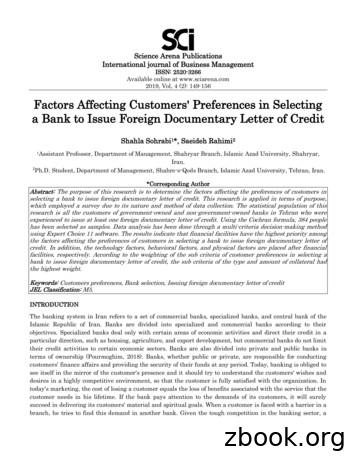FACTORS AFFECTING E-GOVERNMENT IMPLEMENTATION AND ADOPTION .
FACTORS AFFECTING E-GOVERNMENT IMPLEMENTATION ANDADOPTION IN THE STATE OF QATARA Thesis Submitted for the Degree of Doctor of PhilosophyByShafi Homoud Al-ShafiSchool of Information Systems, Computing and MathematicsDepartment of Information Systems and ComputingBrunel University2009
Abstract, Acknowledgement, Table of Content and AbbreviationPhD AbstractElectronic government (e-government) has established as an effective mechanismfor increasing government productivity and efficiency and a key enabler of citizen centric services. However, e-government implementation is surrounded byorganisational, technological, political and social issues, which have to beconsidered and treated carefully in order to facilitate this change. Conversely, froman adoption perspective, e-government services are yet to be universally acceptedas a medium for accessing online public services since its inception more than adecade ago.In terms of prior research into understanding the implementation challenges andadoption factors, most existing literature focus into either the implementationcontext or adoption context separately and no research studies were found that takea holistic viewpoint of both implementation and adoption. Furthermore, only a fewresearchers have explored and reflected on the important factors that can impact egovernment implementation using well founded theoretical models or frameworks.Besides, there is no universal model for e -government implementation and adoptionthat is applicable for all countries to ensure success, es pecially for developing andGulf Cooperation Countries (GCC). Therefore, this thesis attempts to explore andinvestigate the key challenges that influence e -government implementation and thefactors influencing citizen adoption in the state of Qatar. By simultaneouslyanalysing and aligning the implementation issues of e -government with the adoptionaspects, this study aimed to develop a better understanding of the gaps that existsbetween implementation and adoption. Through combining the implementation andadoption aspects of e-government, this thesis proposes a unified conceptual modelwhich could be used as a frame of reference by government institutions that seek toimplement and diffuse e-government systems in Qatar. To do so, the research tutionalTheory(forunderstanding implementation) and the Unified Theory of Acceptance and Use ofTechnology (UTAUT) model (for understanding adoption).The research adopted a multi-method approach [combining qualitative (interviews)and quantitative (survey) methods] to explore practices and experiences ofimplementing and adopting e-government systems in the State of Qatar.Shafi Al-Shafii
Abstract, Acknowledgement, Table of Content and AbbreviationAcknowledgementsPraise to Allah the Almighty, Creator and Sustainers of the Universe, and prayersand blessings are sent on His Prophet.Firstly, I would like to express my deepest gratitude and appreciation to Dr.Vishanth Weerakkody, my academic first supervisor, for h is excellent supervision,guidance, invaluable feedback, and encouragement. Thank you very much Vishanth.I greatly appreciate my thesis second supervisor, Professor Guy Fitzgerald for hisconstructive feedback, generous time, kind support, and advice duri ng my PhD.Thanks a lot Guy.I would like to extend my thanks to H.E. Sheikh Abdullah Bin Nasser Bin KhalifaAl-Thani, Minister of State for Interior Affairs that provide support, andencouragement for my doctoral studies. Also, many thanks to the defence attachéand cultural attaché, and the embassy staff in London. Additionally, many thanks toMs Ella Heaney (PhD Administrator) for her continuous help. Furthermore, a hugethanks to Mrs Carolyn Bailey (Academic Research Manager) for her assistance inediting the thesis. Moreover, many thanks to all staff of the Department ofInformation Systems and Computing (DISC) and Business school for their kindsupport during my PhD study.I acknowledge the organisations that participated in this research and their sta ff, andfor their time and assistance in collecting empirical data to ensure the completion ofthe thesis.My greatest indebtedness is to my wife, and I can not find adequate words toexpress how essential her inspiration and support were to bring me to th is point. Iwould not be here if it was not for her patience, continuous encouragement andthoughtful advice during my work. Also, I owe special thanks to my mother, mydaughters, my sons, my brothers and sisters, and my relatives for their moralsupport, continuous prayers, and endless patience.Lastly, I extend the thanks to all my colleagues at the Department of Inf ormationSystems and Computing, Business school, and other Brunel schools and departmentsfor their continuous encouragement and support, as well as many thanks to all myfriends and colleagues for their time, advice and continuous support.Shafi Al-Shafiii
Abstract, Acknowledgement, Table of Content and AbbreviationDeclarationSome of the material contained herein has been presented in the form of thefollowing publications:Journal PapersPublished/Accepted (In-Press)/Under Review[J5] Al-Shafi, S. and Weerakkody, V. (2010) Conceptual Model for E Government Implementation in the State of Qatar. InternationalJournal of Public Sector Management, Emerald, (Submitted).[J4] Al-Shafi, S. and Weerakkody, V. (2009) E-government Adoption inQatar: Investigating the Citizens‘ Perspective. Journal of ComputerInformation Systems (Submitted).[J3] Al-Shafi, S. and Weerakkody, V. (2009) Implementing Free Wi-Fi inPublic Parks: An Empirical Study in Qatar. International Journal ofElectronic Government Research, 5(3), 21-35, July-September 2009.[J2] Al-Shafi, S. (2008) Free Wireless Internet park Services: AnInvestigation of Technology Adoption in Qatar from a Citizens‘Perspective. Journal of Cases on Information Technology, 10, 21-34.[J1] Al-Shafi, S. and Weerakkody, V. (2007) Implementing and managing egovernment in the State of Qatar: a citizens' perspective. ElectronicGovernment, an International Journal, 4(4), 436-450.Conference Papers[C8]Published/Accepted for PublicationAl-Shafi, S., Weerakkody, V., Lee, H. and Irani, Z. (2009) e. Pre-ICIS Workshop paper,theCitizens‘Special Interest Group onAdoption and Diffusion of Information Technology (SIGADIT) in theInternational Conference on Information Systems (ICIS 2009) ,Phoenix, Arizona, December 15 - 18, 2009 (Accepted).[C7] Al-Shafi, S., Weerakkody, V. , and Janssen, M. (2009). Investigatingthe Adoption of E-government Services in Qatar Using the UTAUTModel. Paper presented at the Proceedings of the 15th AmericasShafi Al-Shafiiii
Abstract, Acknowledgement, Table of Content and AbbreviationConference on Information Systems (AMCIS2009), San Francisco,California, August 6 - 9, 2009, [CD-Proceedings].[C6]AlSobhi, F. and Al-Shafi, S. (2009) Citizens‘ Acceptance Of EGovernment Services: An Empirical Study Of Medina City. Posterpaper presented at the Proceedings of the 15th Americas Conferenceon Information Systems (AMCIS2009), San Francisco, California,August 6 - 9, 2009, [CD-Proceedings].[C5]Al-Shafi, S. and Weerakkody, V. (2009) Understanding Citizens‘Behavioural intention in the Adoption of E-government Services inthe State of Qatar. Paper presented at the Proceedings of the 17thEuropean Conference on Information Systems (ECIS2009), Verona,Italy. [CD-Proceedings].[C4] Al-Shafi, S. and Weerakkody, V. (2008) The Use Of Wireless InternetParks To Facilitate Adoption And Diffusion Of E -GovernmentServices: An Empirical Study In Qatar. Paper presented at theProceedings of the 14th Americas Conference on InformationSystems (AMCIS 2008) Toronto, Ontario, [CD-Proceedings].[C3] Al-Shafi, S. and Weerakkody, V. (2008) Adoption of wireless internetparks: an empirical Study in Qatar. Paper presented at theProceedings of the European and Mediterranean Conference onInformation systems (EMCIS08), Dubai, UAE, [CD-Proceedings].[C2] Al-Shafi, S. and Weerakkody, V. (2007) Exploring E-government in theState of Qatar: Benefits, Challenges and Complexities. Paperpresented at the Proceedings of the European and MediterraneanConference on Information Systems (EMCIS07), Valencia, Spain,[CD-Proceedings].[C1] Al-Shafi, S. and Weerakkody, V. (2007) Implementing and managing egovernment in the State of Qatar: a citizens' perspective. PaperAccepted for the UKAIS 2007 Conference, Manchester, UnitedKingdom.Shafi Al-Shafiiv
Abstract, Acknowledgement, Table of Content and AbbreviationBook Chapter[BC2]Published/Accepted for PublicationAl-Shafi, S. and Weerakkody, V. (2009) ‗Citizen‘s Acceptance XI,E-Government Development and Diffusion: Inhibitors and Facilitatorsof Digital Democracy, Information Science Reference (May, 2009).[BC1]Al-Shafi, S. and Weerakkody, V. (2009) ‗Examining the UnifiedTheory of Acceptance and Use of Technology (UTAUT) of EGovernment Services within the State of Qatar‘. Chapter lGovernment: A Global Perspective. Information Science Reference(May, 2009).Shafi Al-Shafiv
Abstract, Acknowledgement, Table of Content and AbbreviationTable Of ContentsPhD Abstract. iAcknowledgements . iiDeclaration . iiiList of Tables . xiiList of Figures . xivChapter 1: Introduction to the Research Area . 11.1Introduction . 21.2An Overview of Electronic Government . 41.3Research Aims and Objectives . 71.4Context of the Study. 81.5Significance of the Study . 91.6Research Outline . 91.7Conclusions . 13Chapter 2: Literature Review . 142.1 Introduction. 152.2 Emergence of E-government . 152.3 A Taxonomy of E-government Definitions . 172.4 Analysis of E-government Dimensions . 222.4.1 Government-to-Government (G2G) . 232.4.2 Government-to-Business (G2B) . 242.4.3 Government-to-Citizen (G2C). 252.4.4 Government-to-Employee (G2E) . 272.5 Models of the Stages of E-government: An Evolutionary Perspective . 282.6 Motivations for E-government Implementation. 322.7 Characterising E-government Benefits . 352.7.1 Efficiency and Cost Reduction . 372.7.2 Accountability and Transparency . 382.7.3 Customer Centric Focus . 382.7.4 Economic Development . 392.7.5 Accessibility and Availability . 402.8 Challenges to E-government Initiatives . 412.9 Chapter Summary . 43Chapter 3: Conceptual Model . 453.1E-government Implementation: The Government Perspective . 463.1.1Change Management Theories that are Relevant to E-government: . 473.1.2Institutional Theory . 503.1.3Theme 1: Organisational Influence . 523.1.4Theme 2: Technology Influence . 533.1.5Theme 3: Social Influence . 543.1.6Theme 4: Political Influence . 553.1.7Factors Influencing E-government Implementation: The E-government LiteraturePerspectives . 56Shafi Al-Shafivi
Abstract, Acknowledgement, Table of Content and Abbreviation3.1.7.1 Organisational Factors Influencing E-Government Implementation . 57Organisational Structure . 57Power Distribution . 57Information System Strategy Alignment. 57Prioritisation of Deliverables . 58Future Needs of the Organisation . 58Organisational Culture. 58Training . 593.1.7.2 Technical Themes Influencing E-government Implementation . 59Information Technology (IT) Standards: . 59Security and Privacy. 60System Integration . 60E-government Portal and Access . 613.1.7.3 Social Themes Influencing E-government Implementation . 61Citizen-Centric Focus . 61Awareness. 62The Digital Divide . 623.1.7.4 Political Themes Influencing E-government Implementation . 633.1.83.2Government Support . 63Funding . 63Leadership . 63Legislation and Legal . 64A Conceptual Model for E-government Implementation in Qatar . 66E-government Adoption: The Citizens‘ Perspective . 693.2.1Technology Adoption Theories . 693.2.1.1 Theory of Reasoned Action (TRA) . 703.2.1.2 Theory of Planned Behaviour (TPB). 703.2.1.3 Innovation Diffusion Theory (IDT) . 703.2.1.4 Technology Acceptance Model (TAM) . 713.2.1.5 Unified Theory of Acceptance and Use of Technology (UTAUT) . 713.2.2Research Model and Hypotheses for E-government Adoption in Qatar . 733.2.2.1 Performance Expectancy . 753.2.2.2 Effort Expectancy . 753.2.2.3 Social Influence. 763.2.2.4 Facilitating Conditions . 763.2.2.5 Behavioural Intention . 773.2.2.6 Gender . 783.2.2.7 Age . 783.2.2.8 Education Level . 793.3Chapter Summary. 83Chapter 4: Research Methodology .
factors influencing citizen adoption in the state of Qatar. By simultaneously analysing and aligning the implementation issues of e-government with the adoption aspects, this study aimed to develop a better understanding of the gaps that exists between implementation and adoption. Through combining the implementation and
Drugs Affecting Autonomic Nervous System, 2. Drugs Affecting Central Nervous System, 3. Drugs Affecting Cardiovascular System, 4. Drugs Affecting Haemostasis and Thrombosis, 5. Drugs Affecting Renal Function, 6. Drugs Affecting Endocrine System, 7. Drugs Affecting Respiratory System, 8. Drugs Affecting Gastr
on Construction Crew Productivity, and this list highlights 16 factors affecting labor productivity. 6.1 Labor Factors Here are some of the most recognized factors affecting labor productivity in the industry: 1. Overtime Scheduling of extended work days or weeks exceeding a standard eight-hour work day or 40-
Factors affecting adoption What practices have they adopted (or want to? Policy design and opportunities. Davidson, D. Nature Climate Change volume6, pages433–435 (2016) FACTORS AFFECTING CLIMATE BEHAVIORS Belief/perceptions Knowledge Capacity Social networks Environmental factors
Factors Affecting Customer Preferences Identifying the factors affecting customers' preferences in purchasing an investment deposit product and determining priorities of factors such as behavioral and attitudinal, techn
mix were predominantly the major factors influencing the consumers ¶ decision to buy. These was based on durable goods, such as televisions fridge, motor vehicle and etc. Kotler and Armstrong (2007) conducted a research to study factors affecting consumer buying behavior. Amongst all the factors, physical factors, social factors, cultural factors
FACTORS AFFECTING THE DESIGN TIDCKNESS OF BRIDGE SLABS: DESIGN AND PRELIMINARY VERIFICATION OF TEST SETlTP by J. H. Whitt,J. Kim, N. H. Burns, andR. E. Klingner Research Report Number1305·1 Research Project 0-1305 Factors Affecting Design Thickness ofBridge Slabs conducted for the TEXAS DEPARTMENT OF TRANSPORTATION in cooperation with the
Factors Affecting EV Adoption . The factors affecting EV adoption are organized as those that are internal to EVs, like battery performance and price and those that are external, such as fuel prices and charging stations, and the policy mechanisms that may influence adoption.
Piano 2019 & 2020 Piano 2019 & 2020 GRADE 1 THREE PIECES: one chosen by the candidate from each of the three Lists, A, B and C: COMPOSER PIECE / WORK / ARRANGER PUBLICATION (PUBLISHER) 1 Attwood Theme (from Theme and Variations, Sonatina No. 4 in D) Piano Exam Pieces 2019 & 2020, Grade 1 (ABRSM) 2 Duncombe Minuet in C (from First Book of Progressive Lessons) Piano Exam Pieces 2019 & 2020 .























